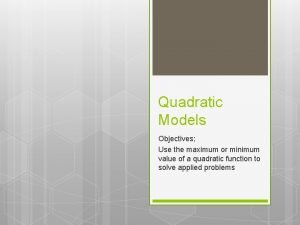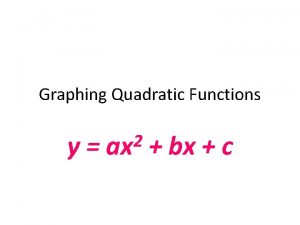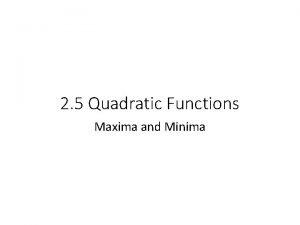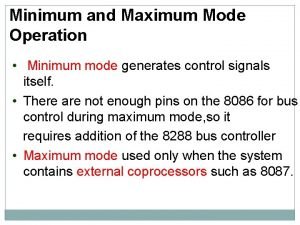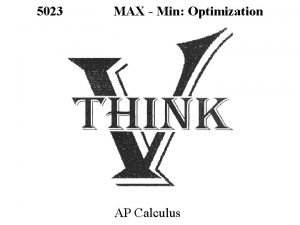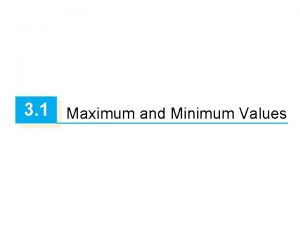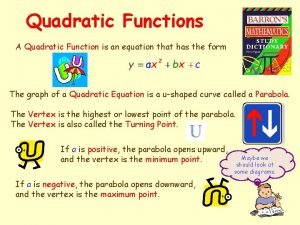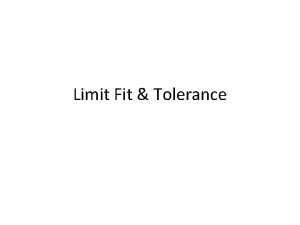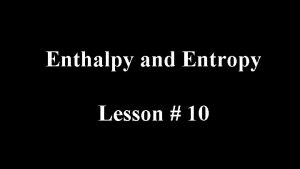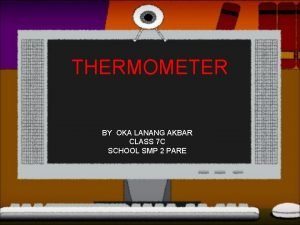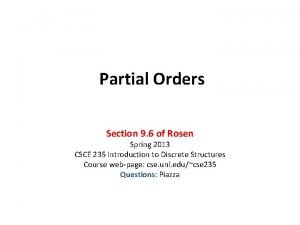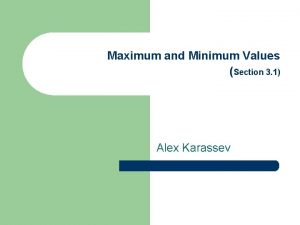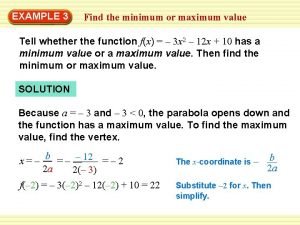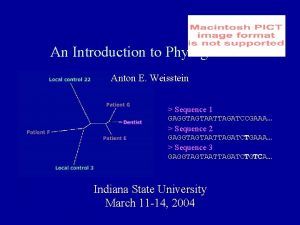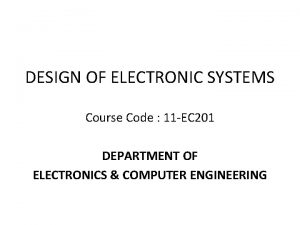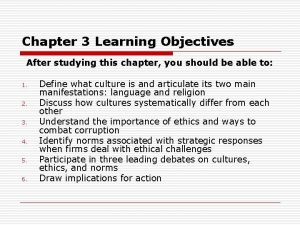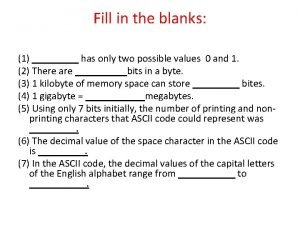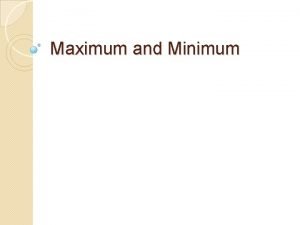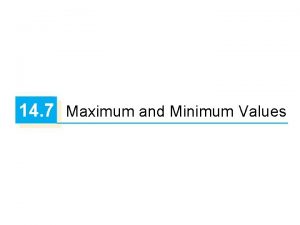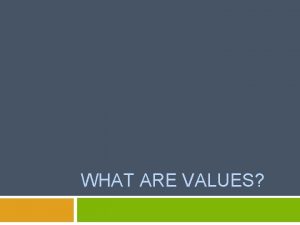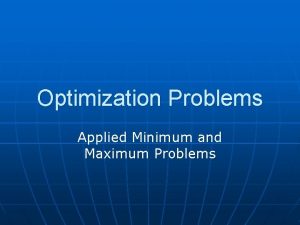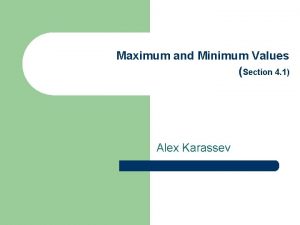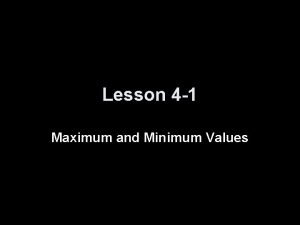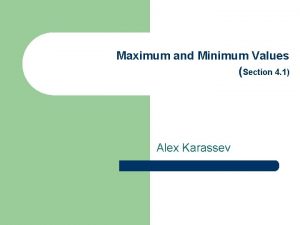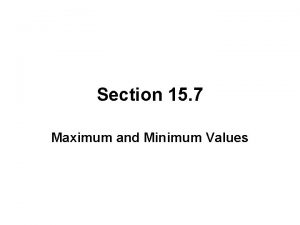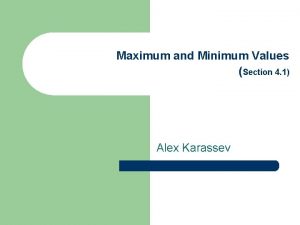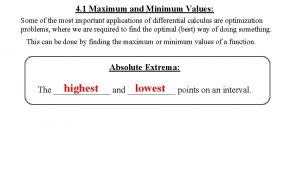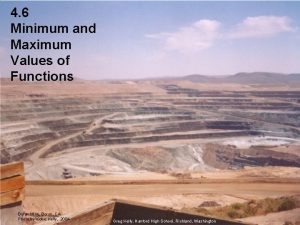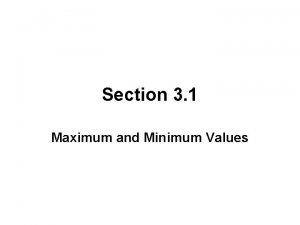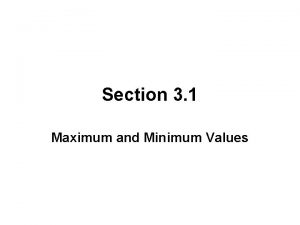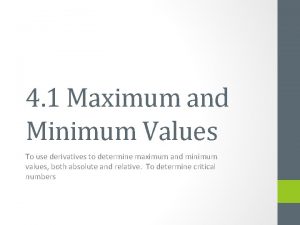Maximum and Minimum Values and Sketch Graphs 2

































- Slides: 33

Maximum and Minimum Values and Sketch Graphs 2. 1 OBJECTIVE • • Find relative extrema of a continuous function using the First-Derivative Test. Sketch graphs of continuous functions. Copyright © 2014 Pearson Education, Inc.

2. 1 Using First Derivatives to Find Maximum and Minimum Values and Sketch Graphs DEFINITIONS: A function f is increasing over I if, for every a and b in I, if a < b, then f (a) < f (b). (If the input a is less than the input b, then the output for a is less than the output for b. A function f is decreasing over I if, for every a and b in I, if a < b, then f (a) > f (b). (If the input a is less than the input b, then the output for a is greater than the output for b. ) Copyright © 2014 Pearson Education, Inc. Slide 2 - 2

2. 1 Using First Derivatives to Find Maximum and Minimum Values and Sketch Graphs THEOREM 1 If f (x) > 0 for all x in an interval I, then f is increasing over I. If f (x) < 0 for all x in an interval I, then f is decreasing over I. Copyright © 2014 Pearson Education, Inc. Slide 2 - 3

2. 1 Using First Derivatives to Find Maximum and Minimum Values and Sketch Graphs DEFINITION: A critical value of a function f is any number c in the domain of f for which the tangent line at (c, f (c)) is horizontal or for which the derivative does not exist. That is, c is a critical value if f (c) exists and f (c) = 0 or f (c) does not exist. Copyright © 2014 Pearson Education, Inc. Slide 2 - 4

2. 1 Using First Derivatives to Find Maximum and Minimum Values and Sketch Graphs DEFINITIONS: Let I be the domain of f : f (c) is a relative minimum if there exists within I an open interval I 1 containing c such that f (c) ≤ f (x) for all x in I 1; and f (c) is a relative maximum if there exists within I an open interval I 2 containing c such that f (c) ≥ f (x) for all x in I 2. Copyright © 2014 Pearson Education, Inc. Slide 2 - 5

2. 1 Using First Derivatives to Find Maximum and Minimum Values and Sketch Graphs THEOREM 2 If a function f has a relative extreme value f (c) on an open interval; then c is a critical value. So, f (c) = 0 or f (c) does not exist. Copyright © 2014 Pearson Education, Inc. Slide 2 - 6

2. 1 Using First Derivatives to Find Maximum and Minimum Values and Sketch Graphs THEOREM 3: The First-Derivative Test for Relative Extrema For any continuous function f that has exactly one critical value c in an open interval (a, b); F 1. f has a relative minimum at c if f (x) < 0 on (a, c) and f (x) > 0 on (c, b). That is, f is decreasing to the left of c and increasing to the right of c. Copyright © 2014 Pearson Education, Inc. Slide 2 - 7

2. 1 Using First Derivatives to Find Maximum and Minimum Values and Sketch Graphs THEOREM 3: The First-Derivative Test for Relative Extrema (continued) F 2. f has a relative maximum at c if f (x) > 0 on (a, c) and f (x) < 0 on (c, b). That is, f is increasing to the left of c and decreasing to the right of c. F 3. f has neither a relative maximum nor a relative minimum at c if f (x) has the same sign on (a, c) and (c, b). Copyright © 2014 Pearson Education, Inc. Slide 2 - 8

2. 1 Using First Derivatives to Find Maximum and Minimum Values and Graph over the f (c) Sign of f (x) Increasing or Sketch Graphs interval (a, b) for x in (a, c) for x in (c, b) decreasing Relative minimum – + Decreasing on (a, c]; increasing on [c, b) Relative maximum + – Increasing on (a, c]; decreasing on [c, b) Copyright © 2014 Pearson Education, Inc. Slide 2 - 9

2. 1 Using First Derivatives to Find Maximum and Minimum Values and Graph over the f (c) Sign of f (x) Increasing or Sketch Graphs interval (a, b) for x in (a, c) for x in (c, b) No relative maxima or minima – – decreasing Decreasing on (a, b) Increasing on (a, b) + Copyright © 2014 Pearson Education, Inc. + Slide 2 - 10

2. 1 Using First Derivatives to Find Maximum and Minimum Values and Sketch Graphs Example 1: Graph the function f given by and find the relative extrema. Suppose that we are trying to graph this function but do not know any calculus. What can we do? We can plot a few points to determine in which direction the graph seems to be turning. Let’s pick some x-values and see what happens. Copyright © 2014 Pearson Education, Inc. Slide 2 - 11

2. 1 Using First Derivatives to Find Maximum and Minimum Values and Sketch Graphs Example 1 (continued): Copyright © 2014 Pearson Education, Inc. Slide 2 - 12

2. 1 Using First Derivatives to Find Maximum and Minimum Values and Example 1 (continued): Sketch Graphs We can see some features of the graph from the sketch. Now we will calculate the coordinates of these features precisely. 1 st find a general expression for the derivative. 2 nd determine where f (x) does not exist or where f (x) = 0. (Since f (x) is a polynomial, there is no value where f (x) does not exist. So, the only possibilities for critical values are where f (x) = 0. ) Copyright © 2014 Pearson Education, Inc. Slide 2 - 13

2. 1 Using First Derivatives to Find Maximum and Minimum Values and Sketch Graphs Example 1 (continued): These two critical values partition the number line into 3 intervals: A (– ∞, – 1), B (– 1, 2), and C (2, ∞). Copyright © 2014 Pearson Education, Inc. Slide 2 - 14

2. 1 Using First Derivatives to Find Maximum and Minimum Values and Sketch Graphs Example 1 (continued): 3 rd analyze the sign of f (x) in each interval. Test Value x = – 2 x=0 x=4 Sign of f (x) + – + Result f is increasing f is decreasing on on (–∞, – 1] [– 1, 2] Copyright © 2014 Pearson Education, Inc. f is increasing on [2, ∞) Slide 2 - 15

2. 1 Using First Derivatives to Find Maximum and Minimum Values and Sketch Graphs Example 1 (concluded): Therefore, by the First-Derivative Test, f has a relative maximum at x = – 1 given by Thus, (– 1, 19) is a relative maximum. And f has a relative minimum at x = 2 given by Thus, (2, – 8) is a relative minimum. Copyright © 2014 Pearson Education, Inc. Slide 2 - 16

2. 1 Using First Derivatives to Find Maximum and Minimum Values and Sketch Graphs Quick Check 1 Graph the function relative extrema. given by , and find the Relative Maximum at: Relative Minimum at: Copyright © 2014 Pearson Education, Inc. Slide 2 - 17

2. 1 Using First Derivatives to Find Maximum and Minimum Values and Sketch Graphs Example 2: Find the relative extrema for the Function f (x) given by Then sketch the graph. 1 st find f (x). Copyright © 2014 Pearson Education, Inc. Slide 2 - 18

2. 1 Using First Derivatives to Find Maximum and Minimum Values and Sketch Graphs Example 2 (continued): Then, find where f (x) does not exist or where f (x) = 0. Note that f (x) does not exist where the denominator equals 0. Since the denominator equals 0 when x = 2, x = 2 is a critical value. f (x) = 0 when the numerator equals 0. Since 2 ≠ 0, f (x) = 0 has no solution. Thus, x = 2 is the only critical value. Copyright © 2014 Pearson Education, Inc. Slide 2 - 19

2. 1 Using First Derivatives to Find Maximum and Minimum Values and Sketch Graphs Example 2 (continued): 3 rd x = 2 partitions the number line into 2 intervals: A (– ∞, 2) and B (2, ∞). So, analyze the signs of f (x) in both intervals. Test Value x=0 x=3 Sign of f (x) – + Result f is decreasing on (– ∞, 2] Copyright © 2014 Pearson Education, Inc. f is increasing on [2, ∞) Slide 2 - 20

2. 1 Using First Derivatives to Find Maximum and Minimum Values and Sketch Graphs Example 2 (continued): Therefore, by the First-Derivative Test, f has a relative minimum at x = 2 given by Thus, (2, 1) is a relative minimum. Copyright © 2014 Pearson Education, Inc. Slide 2 - 21

2. 1 Using First Derivatives to Find Maximum and Minimum Values and Example. Graphs 2 (concluded): Sketch We use the information obtained to sketch the graph below, plotting other function values as needed. Copyright © 2014 Pearson Education, Inc. Slide 2 - 22

2. 1 Using First Derivatives to Find Maximum and Minimum Values and Sketch Graphs Quick Check 2 Find the relative extrema of the function Then sketch the graph. First find given by : Copyright © 2014 Pearson Education, Inc. Slide 2 - 23 .

2. 1 Using First Derivatives to Find Maximum and Minimum Values and Sketch Graphs Quick Check 2 Continued Second find where does not exist or where So and Thus when and . . are the critical values. h’(x) exists everywere. Copyright © 2014 Pearson Education, Inc. Slide 2 - 24

2. 1 Using First Derivatives to Find Maximum and Minimum Values and Quick Check 2 Continued Sketch Graphs Third, and partitions the number line into three intervals: A , B , and C. So analyze the signs of in all three intervals. Interval Test Value Sign of Result Thus, there is a minimum at . Therefore, Copyright © 2014 Pearson Education, Inc. is a minimum. Slide 2 - 25

2. 1 Using First Derivatives to Find Maximum and Minimum Values and Sketch Graphs Quick Check 2 Concluded From the information we have gathered, the graph of Copyright © 2014 Pearson Education, Inc. Slide 2 - 26 looks like:

2. 1 Using First Derivatives to Find Maximum and Minimum Values and Sketch Graphs Quick Check 3 Find the relative extrema of the function Then sketch the graph. First find given by : Copyright © 2014 Pearson Education, Inc. Slide 2 - 27 .

2. 1 Using First Derivatives to Find Maximum and Minimum Values and Sketch Graphs Quick Check 3 Continued Second, find where does not exist or where . Note: does not exist when the denominator = 0. So not exist when. Also, there is no value of that makes. Thus there is a critical value at . Copyright © 2014 Pearson Education, Inc. Slide 2 - 28 does

2. 1 Using First Derivatives to Find Maximum and Minimum Values and Sketch Graphs Quick Check 3 Continued Third, and partitions the number line into two intervals: . So analyze the signs of for both intervals. Interval Test Value Sign of Results Thus there is no extrema for . Copyright © 2014 Pearson Education, Inc. Slide 2 - 29

2. 1 Using First Derivatives to Find Maximum and Minimum Values and Sketch Graphs Quick Check 3 Concluded Using the information gathered, the graph of Copyright © 2014 Pearson Education, Inc. looks like: Slide 2 - 30

2. 1 Using First Derivatives to Find Maximum and Minimum Values and Sketch Graphs Section Summary • A function that is increasing over an interval. if, for all • A function such that is decreasing over an interval. if, for all Copyright © 2014 Pearson Education, Inc. Slide 2 - 31 and such in

2. 1 Using First Derivatives to Find Maximum and Minimum Values and Sketch Graphs Section Summary Continued • Using the first derivative, a function is increasing over an open interval if, for all in , the slope of the tangent line at is positive; that is, . Similarly, a function is decreasing over an open interval if, for all in , the slope of the tangent line is negative; that is. • A critical value is a number in the domain of such that or does not exist. The point is called a critical point. • A relative maximum point is higher than all other points in some interval containing it. Similarly, a relative minimum point is lower than all other points in some interval containing it. The y-value of such a point is called a relative maximum (or minimum) value of the function. Copyright © 2014 Pearson Education, Inc. Slide 2 - 32

2. 1 Using First Derivatives to Find Maximum and Minimum Values and Sketch Graphs Section Summary Concluded • Minimum and maximum points are collectively called extrema. • Critical values are candidates for possible relative extrema. The First-Derivative Test is used to classify a critical value as a relative minimum, a relative maximum, or neither. Copyright © 2014 Pearson Education, Inc. Slide 2 - 33
 Absolute min and max
Absolute min and max Quadratic function maximum
Quadratic function maximum How to find the y intercept of a parabola
How to find the y intercept of a parabola How to find minimum of a quadratic function
How to find minimum of a quadratic function 8086 minimum mode
8086 minimum mode Word problem
Word problem Relative maximum and minimum
Relative maximum and minimum Maximum and minimum derivative
Maximum and minimum derivative What is the difference between maximum and minimum
What is the difference between maximum and minimum Minimum parabola
Minimum parabola Types of fits
Types of fits Minimum metal condition (lml) corresponds to the
Minimum metal condition (lml) corresponds to the Minimum enthalpy and maximum entropy
Minimum enthalpy and maximum entropy Bellani-six thermometer
Bellani-six thermometer Partial order
Partial order Rough sketch and final sketch
Rough sketch and final sketch Minimum median maximum
Minimum median maximum Maximum value
Maximum value Minimum maximum value
Minimum maximum value What must be included on a crime scene sketch?
What must be included on a crime scene sketch? Crime scence investigator
Crime scence investigator Maximum likelihood vs maximum parsimony
Maximum likelihood vs maximum parsimony Maximum likelihood vs maximum parsimony
Maximum likelihood vs maximum parsimony Software implementation of state graph
Software implementation of state graph Graphs that enlighten and graphs that deceive
Graphs that enlighten and graphs that deceive Comparing distance/time graphs to speed/time graphs
Comparing distance/time graphs to speed/time graphs Polynomial end behavior chart
Polynomial end behavior chart Minimum values
Minimum values Bruce maglino workplace values
Bruce maglino workplace values Instrumental values
Instrumental values Western vs eastern values
Western vs eastern values A bit can have only two possible values one and
A bit can have only two possible values one and The concept of human values
The concept of human values Networks and graphs circuits paths and graph structures
Networks and graphs circuits paths and graph structures

